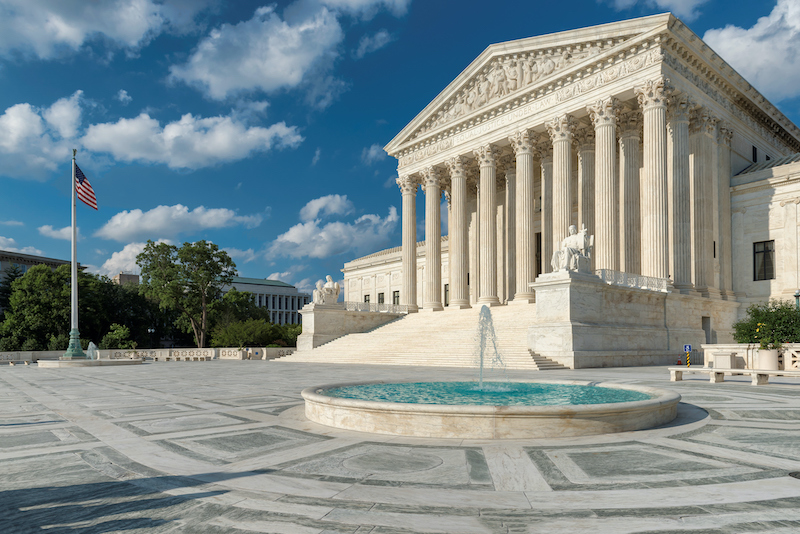
The Supreme Court has destabilized principles on federal agencies’ structures and for-cause removal.
When can Congress protect agency heads from at-will removal by, or at the behest of, the President?
Myers v. United States and Humphrey’s Executor v. United States, two Supreme Court decisions nearing their respective centennials, have long formed a stable basis for assessing the U.S. Congress’s power to provide executive branch officials with for-cause removal protections. Such protections typically limit the grounds for removal to “inefficiency, neglect of duty, and malfeasance in office,” or similar deficiencies.
Under Myers and Humphrey’s Executor, officials who exercise purely executive functions could not be accorded such protections and must be removable at-will by the President. But officials who exercise quasi-judicial and quasi-legislative functions, particularly as members of multi-member commissions or boards, could be afforded for-cause protection.
In Humphrey’s Executor, the Supreme Court reasoned that the President could require subservience from officials exercising executive powers, such as a postmaster or federal prosecutor, for which the President had ultimate responsibility—but not those who exercised the delegated powers assigned to the other branches. Under Humphrey’s Executor, the U.S. Constitution does not require that agency officials whose jobs involve more than just enforcement—such as making rules or holding hearings—be removable at-will by the President, despite being members of the executive branch.
The Supreme Court’s 1988 decision in Morrison v. Olson destabilized this foundation a bit, holding that even some purely executive officials, such as individuals appointed as special counsel, could receive for-cause protection when warranted by their functions.
In 2010, Free Enterprise Fund v. Public Company Accounting Oversight Board further destabilized the framework it established in Myers and Humphrey’s Executor. The question in Free Enterprise centered on the constitutionality of a double level of for-cause protection: Could Congress set up one agency, headed by officials enjoying for-cause protection, that was nested under another agency headed by officials also possessing such protection? The Court’s holding—that Congress could not create more than one level of for-cause insulation between the President and virtually any executive branch officer—was not itself particularly destabilizing. But the majority’s rationale asserted that presidential control over executive branch officials was critical to the President’s electoral accountability. That reasoning did not bode well for Humphrey’s Executor’s continuing validity.
Given the instability of the doctrine and the renewed focus on presidential control over agency officials, the Court’s decision this past term in Seila Law v. CFPB was much anticipated.
Seila involved the removal protections Congress gave to the director of the Consumer Financial Protection Bureau (CFPB), an agency that exercises substantial quasi-judicial and quasi-legislative functions. The issue before the Court centered on the viability of the Humphrey’s Executor framework: Would the insulation the Court affirmed in Humphrey’s Executor apply even to a solitary agency head, an official freed from operating in a multi-member environment? Or would the Court jettison Humphrey’s Executor altogether and enshrine the unitary executive theory as constitutional law?
The CFPB case raised these issues in a disturbing context. In creating the CFPB, not only had Congress protected its director with a for-cause removal provision, but Congress had also allowed the director to serve for a five-year term. This structure meant that a President could serve an entire term without gaining an opportunity to replace the CFPB’s director with someone more in tune with the President’s philosophy.
Moreover, the CFPB’s budget stems from a source entirely separate from the congressional appropriations process, as the CFPB is funded from bank fees collected by the Federal Reserve. The CFPB also has its own litigating authority, independent of the Attorney General. Substantively, the CFPB possesses broad authority to address issues that are quite controversial and could have broad impacts both on businesses and the general public.
In deciding that the CFPB director’s removal protections were unconstitutional, the Supreme Court split along expected ideological lines. The five conservative justices sought to limit Humphrey’s Executor, with Justice Clarence Thomas, joined by Justice Neil Gorsuch, urging its complete abandonment. The four liberal justices sought to reaffirm what they considered to be Humphrey’s Executor’s broad reach.
The Court—with Chief Justice John Roberts writing for the majority—cited to great effect the CFPB’s single-headed agency structure, the director’s five-year term, and the CFPB’s financial independence and litigating authority as establishing a center of power controlled by one person. This structure, the Court explained, allowed the CFPB director to operate largely independent of the primary tools the political branches may use to control executive branch officials—namely, the prospect of at-will removal by the President and Congress’s appropriations process. But the Court eschewed reliance on such a contextual analysis in setting forth the legal rule upon which it rested its decision.
Under Seila, an executive officer who is the sole head of an agency cannot have for-cause removal protection, even if that officer exercises only quasi-judicial or quasi-legislative functions. Such an official’s powers must be cabined—either by having to work within a multi-member board or commission framework, or by being subject to at-will removal by the President.
In so holding, the Court refused to extend Humphrey’s Executor beyond the multi-member commission setting. In the majority’s view, such a rule was necessary to ensure that the President would remain politically accountable for the actions of principal officers within the executive branch. As Justice Elena Kagan’s dissent noted, however, the multi-member commission format complicates presidential control since a single agency director is easier to control than a multi-member commission or board.
One might wonder if the Court makes too much of the distinction between single-headed agencies and multi-member entities. Given the current political polarization, the manner of nominating and confirming officials to multi-member bodies, and the considerable powers that many commission and board chairs hold, some agencies—such as the Federal Reserve, the Securities and Exchange Commission, and the Federal Communication Commission—appear to be largely run by individual chairpersons of their commissions or boards.
In dissent, Justice Kagan, writing an opinion joined by the other three liberal justices, began with a quite different premise than that embraced by Justice Roberts. She observed that the Court had repeatedly upheld provisions that prevent the President from firing regulatory officials except for cause, cautioning only that Congress could not impede the President’s performance of his constitutional duties through imposing removal restrictions. “Within that broad limit,” Justice Kagan asserted, the Court had maintained that “Congress could protect from at-will removal the officials it deemed to need some independence from political pressures.”
Justice Kagan ultimately concluded that questions of agency design, removal protections, and the balance between the need for independence and political responsiveness are ones most appropriately left to the political branches of government. Justice Kagan is correct that an agency’s independence, or lack thereof, “depends on a wealth of features,” which include removal standards, internal agency procedures and organization, cultural norms and traditions, and even the personal relationships between bureaucrats and politicians.
The majority’s “rule” governing for-cause protections may well be challenged as naively unsophisticated—as Justice Kagan does by describing it as the “Schoolhouse Rock” separation of powers theory. One might have also offered the same criticism of Free Enterprise’s one-level limitation on for-cause protection.
Nevertheless, in the context of the CFPB director, the majority may well have a point. The combination of the director’s for-cause protection and lengthy term, as well as the agency’s independent budgetary and litigating authority controlled by a single individual, is arguably a disturbing concentration of power.
But what would be the result if the majority relied upon the troubling characteristics of the CFPB and the tenure protection enjoyed by its director to hold that in combination those factors made the agency’s structure too independent of the President and Congress?
Such a ruling would have been narrower, based on the specific facts of the case, and perhaps easier to defend against Justice Kagan’s challenge. But it would also have meant that many arrangements providing for-cause protection might be subject to a functionalist analysis that must account for all of the circumstances, rather than the relatively straightforward formalist rule the majority imposed prohibiting for-cause protection for single-headed agencies.
What is more, none of the CFPB’s circumstantial characteristics are entirely unusual, as many independent agencies have some degree of insulation with regard to budgetary and litigation authority. And many other agencies also address controversial subjects that have broad impact.
In Justice Kagan’s hands, a more holistic approach would create little uncertainty. Virtually any arrangement, outside of those involving military and diplomatic affairs, would pass constitutional muster. But in the hands of the conservative majority, who believe in robust limitations on insulating executive branch officials, cases challenging the constitutionality of agency structures could likely turn on a combination of a myriad of interacting factors. Even after a string of Supreme Court decisions, the outcomes of these challenges would likely remain uncertain.
Indeed, the more holistic approach, in conservative hands, might begin to resemble the administrative law doctrine governing when Congress can assign adjudicatory powers to non-Article-III courts. The precedents underlying that doctrine, as Justice Sandra Day O’Connor quite frankly acknowledged in 1986, “do not admit of easy synthesis.” And perhaps she should have omitted the word “easy.”
The majority’s rule in Seila, although absolute in its way, leaves questions unanswered. And although the “rule” may seem simplistic, and perhaps not entirely coherent conceptually, it does set forth a robust limit on Congress’s ability to constrain removal—an important aspect of presidential control—without launching the Court into an era of intrusive review of agency design best left to the political branches of government and to scholars.
The Court, however, does not appear to have finished with its consideration of for-cause removal protections. Within ten days of its decision in Seila Law, the Court granted certiorari in Collins v. Mnuchin and set the case for full briefing and argument. Collins involves a removal provision that affords for-cause protection to the head of the Federal Housing Finance Agency. The statute in question actually uses the term “for cause” rather than the typical “inefficiency, neglect of duty, and malfeasance in office” phraseology.
With Collins on its docket, next term the Court may refine the constitutional principles announced in Seila Law or construe the term “for cause” as used in a statutory removal provision.
This essay is part of a series entitled The Supreme Court’s 2019-2020 Regulatory Term.




